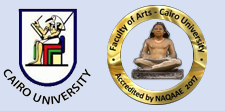عنوان المقال عربي
تمثيل المرأة المسلمة المحجبة في COHA بين 1820 و 2019: دراسة زمنية مستندة على المتن اللغوى
Document Type
Original Study
Subject Area
Language and Literature
Keywords English
hijab, Muslim women representation, prosody, ideology, COHA
كلمات مفتاحية عربي
حجاب، صورة المرأة المسلمة، دلالة الإقتران، أيديلوجى، مخزون نصوص تاريخية أمريكية
Abstract English
This is a diachronic corpus-based study that aimed to explore how hijabi Muslim women were represented in the Corpus of Historical American English (COHA) between 1820 and 2019. The study used corpus linguistics in conjunction with critical discourse analysis, particularly van Dijk’s (2000) theoretical framework that analyzes the relation between discourse and ideology. The loan word hijab used in American texts was examined diachronically to find out whether there was bias against the religion of Islam in the use of language. Therefore, the frequency of the word, its contexts, prosodies and senses were explored. The study found out that hijab experienced semantic change, namely specialization, giving the meaning of a head scarf. The frequency of hijab increased over the period the corpus spans. Different genres featured the word hijab with negative, neutral and positive prosodies, but positive representation of hijabi women gradually grew towards the end of the time period. The study concluded that the negative representation of Muslim women wearing hijab indicated prejudice in language use as a result of the political atmosphere following 9/11 attacks, and the positive prosodies boosted with the passage of time in the corpus reflected the opposition of social actors to discriminatory acts.
الملخص العربي
اعتمدت هذه الدراسة على مخزون من النصوص الرقمية للبحث فى كيفية تغير اللغة على مدار التاريخ. هدف هذا البحث إلى معرفة كيف تم تمثيل المرأة المحجبة فى مخزون نصوص تاريخية أمريكية (COHA) من عام 1820 حتى 2019. تم تحليل كلمة حجاب تاريخيا لفحص ما إذا كان هناك انحياز ضد الإسلام فى الإستخدام اللغوى. واستخدمت الدراسة المخزون اللغوى مع تحليل الخطاب النقدى، وتحديدا الإطار النظرى الذى اقترحه van Dijk (2000) لتحليل العلاقة بين الخطاب والأيديولوجى. تم دراسة عدد مرات استخدام الكلمة وسياقها ومدلولها ومعناها. وجدت الدراسة أن كلمة حجاب قد تعرضت إلى تغيردلالى، وبالتحديد التخصيص والذى استقر على معنى غطاء الرأس. زاد عدد مرات استخدام كلمة حجاب على مدى الفترة التى يغطيها مخزون النصوص التاريخية الأمريكية. ووجدت الكلمة فى أنواع مختلفة من النصوص بمدلولات سلبية ومحايدة وإيجابية. ولوحظ زيادة متدرجة فى تمثيل المرأة بصورة إيجابية حتى نهاية الفترة. خلصت الدراسة إلى أنه دل تمثيل المرأة المحجبة بصورة سلبية على الانحياز ضد الإسلام فى الإستخدام اللغوى نتيجة للمناخ السياسى عقب أحداث 11/9، وعكست الصورة الإيجابية التى تم تعزيزها بمرور الوقت فى مخزون النصوص الأمريكية معارضة أصحاب الأدوار الفاعلة فى المجتمع للممارسات التمييزية.
Recommended Citation
Sallam, Samar
(2024)
"Hijabi Muslim Women Representation in COHA between 1820 and 2019: A Diachronic Corpus-Based Study,"
Journal of the Faculty of Arts (JFA): Vol. 84:
Iss.
3, Article 21.
Accept Date
2024-07-24
Publication Date
7-1-2024

